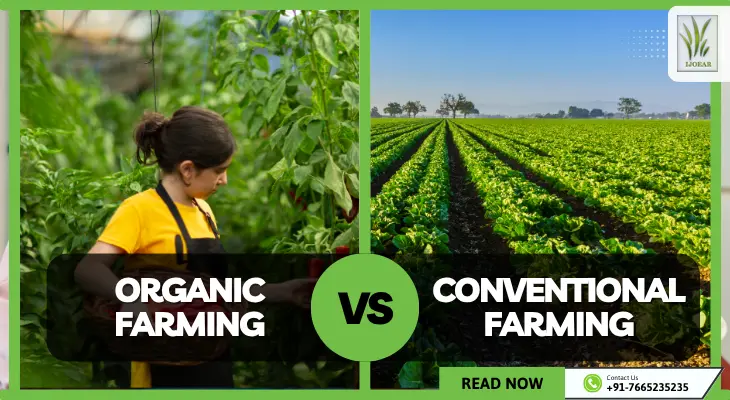
Farming plays a big role in how we grow food and take care of the Earth. Two major types of farming today are organic farming and conventional farming. Both have their own ways of working and different effects on the environment. But which one is more sustainable? Let’s explore.
Organic farming is a natural way of growing food. It avoids harmful chemicals and focuses on healthy soil, clean water, and biodiversity. This method follows strict guidelines that aim to protect the environment and human health.
Conventional farming, also known as industrial farming, uses modern technology and chemicals to grow large amounts of food quickly. This method became popular after the Green Revolution to meet growing food demands.
Let’s see how each type of farming performs in terms of sustainability. Here’s a side-by-side comparison to help understand how these systems perform in terms of sustainability:
| Factor | Organic Farming | Conventional Farming |
|---|---|---|
| Soil Health | Builds soil fertility naturally through compost and crop rotation | Depletes soil nutrients; overuse of chemicals can lead to erosion |
| Water Conservation | Efficient use of water; avoids chemical runoff into water sources | Often wastes water through large-scale irrigation; leads to pollution |
| Chemical Use | Avoids harmful pesticides and fertilizers | Heavy use of synthetic chemicals that harm the environment |
| Biodiversity | Promotes pollinators, birds, and natural predators | Destroys habitats and reduces wildlife diversity |
| Energy Consumption | Low energy input (manual or small-scale tools) | High energy use due to machines and chemical production |
| Greenhouse Emissions | Lower emissions due to natural practices | Higher emissions from machinery, fertilizers, and livestock waste |
| Crop Yield | Usually lower per acre | Higher productivity per acre |
| Cost of Production | Often higher, especially in labor and certification | Lower due to economies of scale |
| Health Impact | Lower chemical residue in food; supports safer ecosystems | Food may have chemical residues; long-term health effects are debated |
Sustainability means meeting today’s needs without harming the ability of future generations to meet theirs. It includes environmental health, economic strength, and social well-being.
Organic farming is more sustainable in terms of:
However, it has some challenges:
Conventional farming is better for:
But it comes at a cost—damaging soil, water, air, and biodiversity over time.
The future of farming may lie in integrated or sustainable farming, which blends the best of both worlds. For example:
When we think long-term, organic farming offers more benefits to the environment and supports sustainability goals. But to ensure global food security, we also need the productivity of conventional farming. The solution is not to choose one over the other, but to combine techniques and move toward a sustainable agricultural future.
Q1. What is the main difference between organic and conventional farming?
A: Organic farming avoids chemical fertilizers, pesticides, and GMOs, focusing on natural methods. Conventional farming uses synthetic chemicals, machines, and modified seeds to grow food faster and in larger quantities.
Q2. Is organic farming better for the environment?
A: Yes. Organic farming helps improve soil health, saves water, reduces pollution, and supports biodiversity. It has a smaller carbon footprint compared to conventional farming.
Q3. Why is conventional farming still widely used?
A: Conventional farming produces more food at a lower cost and helps feed growing populations. It also uses machines and chemicals that speed up crop growth.
Q4. Does organic farming produce enough food for everyone?
A: Organic farming usually has lower yields, which means it may not produce as much food as conventional methods. However, it offers long-term environmental benefits and safer food.
Q5. Which type of farming is more sustainable?
A: Organic farming is generally more sustainable because it protects natural resources and reduces harm to the planet. But combining good practices from both systems may offer the best results.
Q6. Is food from organic farming healthier?
A: Organic food usually contains fewer chemical residues and is grown without artificial hormones or GMOs. Many people prefer it for health and environmental reasons.
Q7. Why is organic food more expensive?
A: Organic farming takes more time, effort, and care. It avoids shortcuts like chemical use and often requires manual labor, which increases the cost.
Q8. Can small farmers shift to organic farming easily?
A: It can be challenging at first due to certification costs and training needs. But with proper support and time, many small farmers benefit from organic practices and earn better prices for their crops.
Q9. How does organic farming support biodiversity?
A: Organic farms avoid harmful pesticides, so insects, birds, and other animals can thrive. This improves pollination, pest control, and ecosystem health.
Q10. Are there any disadvantages of organic farming?
A: Yes. Organic farming may have lower yields, higher labor costs, and requires more knowledge and care. It also needs time to improve soil naturally.
 NAAS Rating: 4.23
NAAS Rating: 4.23  October 2025 Issue
October 2025 Issue  Impact Factor: 6.69
Impact Factor: 6.69  Submit Article
Submit Article 
|
Citation Indices
|
All
|
Since 2020
|
|
Citation
|
6164
|
5117
|
|
h-index
|
31
|
29
|
|
i10-index
|
201
|
165
|
|
Acceptance Rate (By Year)
|
|
|
Year
|
Percentage
|
|
2024
|
11.09%
|
|
2023
|
15.23%
|
|
2022
|
12.81%
|
|
2021
|
10.45%
|
|
2020
|
9.6%
|
|
2019
|
14.3%
|
|
2018
|
17.65%
|
|
2017
|
16.9%
|
|
2016
|
22.9%
|
|
2015
|
26.1%
|